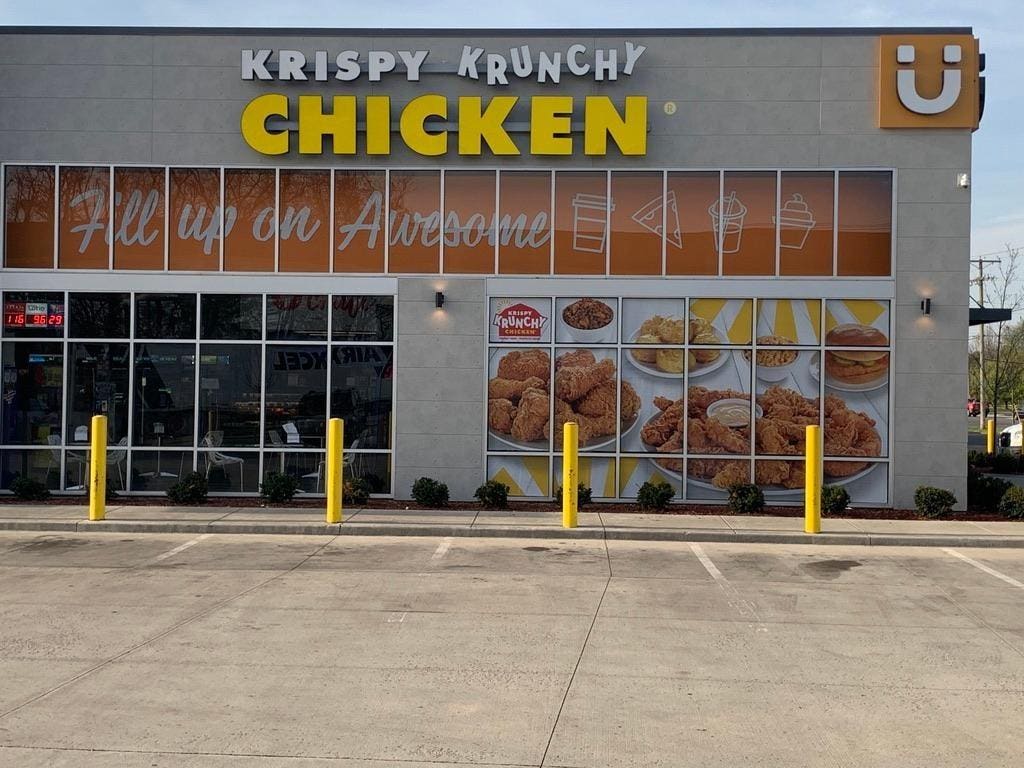Mention crispy chicken sandwiches to most American consumers, and a host of brand names spring to mind including Chick-fil-A, KFC, and Popeyes. But there’s another crispy chicken establishment that nearly blankets the country, but operates slightly behind the scenes: Krispy Krunchy Chicken.
Most of its 2,850 locations, found in 47 states, are situated inside of gas stations and convenience stores. Hence, its name may be obscured, but nonetheless, it represents a force in the crispy chicken wars.
In fact, 97% of its locations are situated inside of convenience stores, so they’re not stand-alone stores like the aforementioned competitors. And the remaining 3% can be found inside of school campuses, casinos and now select Wal-Marts.
Krispy Krunchy Chicken may not be a household name, but it’s growing at a rapid pace, fueled by its private equity owner, Main Post Partners.
It faces heated competition from other convenience stores that sell crispy chicken, such as Golden Chicken, Royal Farms Fried Chicken and Casey’s General Store. It launched in 1989 in Lafayette, La., but its headquarters is moving to Atlanta.
Why Licensing Works
Unlike the stand-alone crispy chicken specialists, Krispy Krunchy Chicken outlets don’t pay franchise or royalty fees. Instead it operates on licensing agreements, which its president Jim Norberg, who was hired in 2022, said, “keep things simple for our operators.”
The bottom-line, Norberg noted, is Krispy Krunchy Chicken obtains 15% to 20% of a convenience’s store gross sales. He said it provides them with a competitive edge over those convenience stores that don’t offer a hot food program.
But it also benefits the licensee in other ways since they are not burdened by paying royalties and Norberg says it’s easy to enter into a partnership. “We’re a store within a store. We’re there to increase merchandising sales and make it a destination,” he said.
Besides fried chicken, chicken tenders and honey buttered-fried shrimp, its offers honey butter biscuits, red beans, rice, jambalaya, mac-n-cheese or mashed potatoes
Norberg says that its fried chicken and chicken tender recipe differentiates it from its slew of rivals. “It’s marinated with mild Cajun spices and hand-breaded,” he said.
Needs to Increase Its Brand Recognition
Asked how Krispy Krunchy Chicken reacts to not being a household name like some of its competitors, Norberg, who was formerly COO of McDonald’s where he spent 34 years, replied “That’s the exciting thing. We’re not a household name yet. We’re a word-of-mouth model,” he said.
Norberg said it is striving to extend its brand recognition, and has installed a new marketing team, is stepping up its rebranding efforts, and “letting people know from the street to the pumps to the convenience store that we’re there.”
But he noted it’s on the move and on the rise, and will have opened 300 new stores by the end of the year, bringing it to around 3,000 locations.
Private Equity Ownership Boosts Expansion
What has also boosted the growth and trajectory of Krispy Krunchy Chicken was an infusion of capital in 2021 by its new owner, the private equity firm, Main Post Partners, which is based in San Fransisco and has invested in chains such as Viva Chicken and the Flynn Restaurant Group.
“We have experienced substantial opportunities in unlocking the brand’s potential and consumer awareness by partnering with Main Post Partners,” Norberg stated.
Indeed Norberg described Main Post Partners as “not your father’s private equity company. They walk the talk and talk about partnership, not ownership.” He pointed out that they built up Jimmy John’s submarine shops (which number over 2,750 stores) and so have a track record of success.
Asked specifically what assistance Main Post Partners offers, Norberg replied, “analytics, technology and data, insights about the customers, and choosing the right strategic growth paths.”
Consumer reaction on Yelp from those who dined at the Krispy Krunchy Chicken in Brooklyn, N.Y. was revealing. Natalyia from Brooklyn said she finds herself at Krispy Krunchy Chicken when she’s in a “fried chicken craving mood.” She said the menu is “centered around greasy or fried chicken,” but there’s more to life than pretentious salads.
Furthermore, she said $15 “can get you more food than two people in my household can eat including chicken, sides, and beverage.”
Growth is fueling Krispy Krunchy Chicken. “We’re in 7 locations in Wal-Mart. As a store within a store, we can fit in almost anywhere.”
Norberg noted it is located in the front of the Walmart where other food services have been situated such as McDonald’s or Subway, something he clearly learned in his COO position at McDonald’s. Asked if it will vie for placement at other supermarkets, he replied “our goal is to serve our craveable fried chicken wherever there are hungry people.”
Savvy Norberg acknowledged that too fast growth can lead to disaster and managerial problems, but he said, “Our model makes it easier. We don’t own the store. We own the license.”
He described the three keys to its future success as: 1) Brand Awareness, 2) Convenience, in several ways, 3) Providing consistently outstanding fried chicken.
Asked why its name Krispy Krunchy Chicken contains two misspellings of “crispy and crunchy,” Norberg laughed and said, that was the original owners inside joke. “The brand is about being playful and fun,” he stated.
Read the full article here





